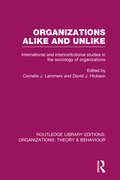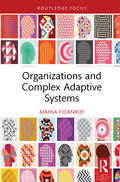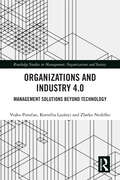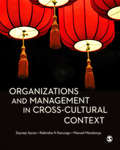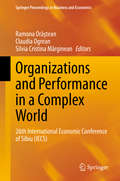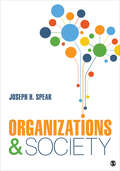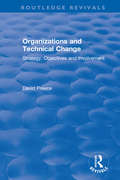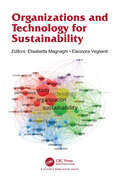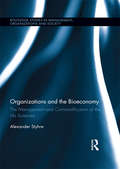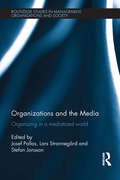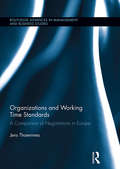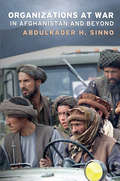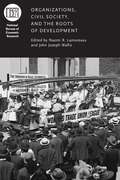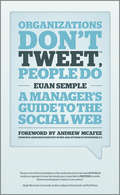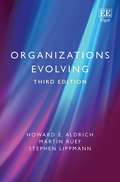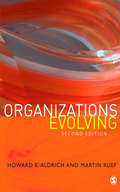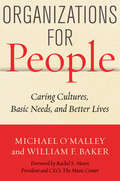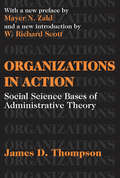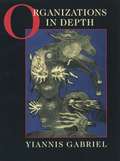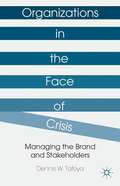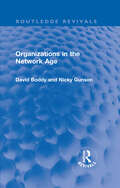- Table View
- List View
Organizations Alike and Unlike: International and Inter-Institutional Studies in the Sociology of Organizations (Routledge Library Editions: Organizations)
by David J. Hickson Cornelis J. LammersThis volume contrasts the life and problems of organizations in many parts of the world and highlights the differences between those societies as reflected in their different institutional sectors such as manufacturing, commerce, social services and government administration. In so doing, the book contributes to the theoretical foundations of the sociology of organizations by revealing previously unseen relationships between societies and institutions, offering an original synthesis of available research.
Organizations and Complex Adaptive Systems (Routledge Focus on Business and Management)
by Mahsa FidanboyOrganizations and Complex Adaptive Systems explains complexity theory within the organizational studies and discusses the applicability of complex adaptive systems principles for intraorganizational and interorganizational levels. Complex adaptive systems and complexity theory have been studied in many different fields of science. When studying the application of complex adaptive systems within social sciences, not many are seen in real terms in contrary to the myriads of theories and propositions available. The complex adaptive systems perspective is presented in quantitative terms in natural sciences, but a quantitative approach has not been used within social sciences a lot comparatively. This book links the basics of complex adaptive systems to social sciences, focusing on organizational studies and covering interorganizational, organizational, and individual levels. It shows the latest state of knowledge on the topic and will be of interest to researchers, academics, managers, and students in the fields of management, organizational theory and behavior, and strategic management.
Organizations and Industry 4.0: Management Solutions Beyond Technology (Routledge Studies in Management, Organizations and Society)
by Zlatko Nedelko Vojko Potočan Kornélia LazányiKnown models for assessing the readiness and level of Industry 4.0 implementation are helpful in revealing key technological and non-technological aspects relevant in the frame of Industry 4.0 implementation in organizations. At the forefront are technological aspects of Industry 4.0 implementation in organizations, while non-technological aspects play a marginal role. Building upon ample evidence about the role of non-technological aspects of Industry 4.0 implementation in organizations, this book addresses these ever-important non-technological aspects.The authors address the role of management solutions in the framework of Industry 4.0 implementation through the utilization of various management tools, which support organizations working in all organizational areas. The importance of humans for Industry 4.0 is currently severely neglected, despite the many changes in the workplace. Thus, new challenges for human resource management (HRM) have emerged, such as technostress, human–robot interaction (HRI), and new tasks for employees. Non-technological aspects of Industry 4.0 are broadly influencing entire organizations, as the management tools support the working of organizations in all areas. Focusing on non-technological aspects of Industry 4.0 implementation, this book considers the utilization of traditional management tools as a key vehicle for supporting implementation in organizations. In terms of the importance of humans for implementation, at the forefront are changes in the workplace due to Industry 4.0, HRIs, and changing HRM practices.This book will be of value to researchers, academics, and advanced students in the fields of organizational studies, HRM, and change management.
Organizations and Management in Cross-Cultural Context
by Rabindra N. Kanungo Manuel Mendonca Zeynep Aycan*Shortlisted for the CMI Management Book of the Year Award 2014 in the textbook category*<P><P> An ideal course text for Organizational Behaviour, Human Resource Management or Cross-Cultural Management courses. <P> * Chapters present the fundamental theoretical approaches in all key areas including leadership, ethics and change, and then explore them in the context of culture and cross-cultural management. <P> * Encourages self-reflection and critical appraisal through a series of questions and scenarios designed to get you thinking like a manager working with an international team. <P> * Provides practical guidance on tackling the most complex issues facing managers today. <P> * Contains insights into the experiences of real employees working in a multicultural environment. <P> The companion website www.sagepub.co.uk/kanungo provides a wealth of additional material to support students and teachers alike.
Organizations and Performance in a Complex World: 26th International Economic Conference of Sibiu (IECS) (Springer Proceedings in Business and Economics)
by Ramona Orăștean Claudia Ogrean Silvia Cristina MărgineanThis volume highlights current research and developments on organizations and (their) performance against the background of ubiquitous complexity. It investigates some of the challenges and trends dominating the complex world of nowadays and the ways organizations are dealing with them in their continuous search for performance. The papers in the volume cover a series of hot and/or emerging topics (i.e. sustainable development, corporate social responsibility, green marketing, digital revolution, social media, global trade, intangible assets, economic intelligence and innovation).Built on an interdisciplinary perspective and a multi-level approach―global (trade, power, sustainable development), regional (EU, BRICS), national (country-based systems, cultures, policies, practices), industry (airlines, pharma, luxury, retailing, banking, tourism), local (communities, destinations), and organization (entrepreneurship, MNEs, public organizations: national and local)―the volume uniquely addresses issues of high interest for researchers, practitioners and policymakers.
Organizations and Society
by Joseph H. SpearWhat are the costs and consequences of living in a society that has undergone an "organizational revolution"? To what extent is social life in the 21st century dominated by the rational control that is characteristic of bureaucratic organizations large and small? Organizations and Society addresses these broader human questions with a critical perspective, while at the same time explaining the main concepts and theories in the field. Students of all interests—those who wish to run organizations someday, study them, or simply understand their importance in the contemporary social order—will benefit from the insights and cogent arguments of this text for undergraduate classrooms.
Organizations and Society
by Joseph H. SpearWhat are the costs and consequences of living in a society that has undergone an "organizational revolution"? To what extent is social life in the 21st century dominated by the rational control that is characteristic of bureaucratic organizations large and small? Organizations and Society addresses these broader human questions with a critical perspective, while at the same time explaining the main concepts and theories in the field. Students of all interests—those who wish to run organizations someday, study them, or simply understand their importance in the contemporary social order—will benefit from the insights and cogent arguments of this text for undergraduate classrooms.
Organizations and Technical Change: Strategy, Objectives and Involvement (Routledge Revivals)
by David PreeceFirst published in 1995, Organizations and Technical Change examines the key changes that have taken place in the external and internal contexts of organizations which have experienced technical change. It reviews and assesses major elements of new technology, including: the development of strategy; the setting of objectives; employee involvement; and the management of the adoption process. Through four case studies, the book considers in detail a variety of approaches and shows how the adoption of technology and the issues involved have changed since the 1980s.
Organizations and Technology for Sustainability
by Elisabetta Magnaghi Eleonora VegliantiThis book presents insights on digital transformation with a multidisciplinary lens. Collecting chapters from several management perspectives, it provides perspectives on the role of various concepts and elements that are needed by our organizations to win in today’s competition. This book is a contribution to the organizational, to the information and communication technology (ICT) as well as to the sustainability discussion. Here, the readers can find heterogenous inputs to better understand the organizational and technological aspects considering a sustainable business approach. This book is for academicians, students and practitioners interested in the interplay among IT-based solutions, organizational entities and sustainability issues.
Organizations and the Bioeconomy: The Management and Commodification of the Life Sciences (Routledge Studies in Management, Organizations and Society)
by Alexander StyhreThe advancement of the life sciences and the technosciences has enhanced the longevity of citizens in the Western world, and half of the generation born in the first decade of the new millennium is now expected to live to the age of one hundred years. In a society with such longevity and affluence, consumption of health-related goods and services such as pharmaceuticals and scanning procedures may be seen as a sustainable source of income for the industries that promote it. Though the healthcare sector has traditionally been organized in the public sector in Europe and in the private sector in the US, the recent advancement of new therapies and direct-to-consumer marketing have opened up new streams of consumption and revenue for health care goods and services around the globe. This book examines the so-called ‘bioeconomy’ as a new economic and commercial field that emphasizes the management of individual life, including the regulation and control of weight and food consumption and other issues pertaining to individual well-being. In addition, the bioeconomy includes a variety of practices based on commercial interests such as organ donations, reproductive medicine and technologies, and what has been referred to as the tissue economy – the various forms of trade with human tissues. Author Alexander Styhre provides a thorough introduction to the bioeconomy, exploring this new and unique intersection of the life sciences and the technosciences with more traditional consumer markets.
Organizations and the Media: Organizing in a Mediatized World (Routledge Studies in Management, Organizations and Society)
by Stefan Jonsson Josef Pallas Lars StrannegårdThe relationship between media and the organizations they cover has changed dramatically in the last few decades, which have witnessed a huge expansion of news coverage focusing on different types of organizations and their activities. In parallel, organizations have dramatically increased their investment in public relations and other media-oriented forms of communication. Like other societal developments – globalization, marketization, individualization, scientification – mediatization has become an institutional force. This book analyses the mediatization of contemporary organizations and how individual organizations, industry or markets are scrutinized. It examines its key influence on the actions of organizations, and how it shaptes the entire landscape in which the organizations operate. What such a perspective provides is the accentuation of the interplay between organizations and different parts of the society as embedded in the media and its logic. This will be essential reading for professionals, academics and advanced students in organizational studies, public relations and media studies.
Organizations and the Natural Environment: Innovations in Sustainability
by Alfred A. MarcusTo what extent can competition between companies encourage innovations in sustainability that have the potential to solve some of the world's major challenges? Using a series of case studies, this book pits closely related competitors against each other to examine the progress in and obstacles to the evolution of sustainable innovations in energy efficiency, solar power, electric vehicles and hybrids, wind energy, healthy eating, and agricultural productivity. It delves into the efforts of Tesla Motors to bring about a revolution in personal transportation, and the challenges Toyota and General Motors (GM) confront in commercializing hybrids. It explores the movement to healthy food by cereal companies General Mills and Kellogg's, and depicts the battles between Whole Foods and Walmart for the world's palate. By examining the experiences that particular businesses have had with sustainable innovation, this insightful book reflects upon lessons learned and encourages readers to think carefully about the challenges that lie ahead.
Organizations and Unusual Routines
by Ronald E. Rice Stephen D. CooperEveryone working in organizations will, from time to time, experience frustrations and problems when trying to accomplish tasks that are a required part of their role. In such cases it is normal for people to find ways of completing their work in such a way that they can get around, or just simply avoid, the procedure or system that has caused the problem. This is an unusual routine - a recurrent interaction pattern in which someone encounters a problem when trying to accomplish normal activities by following standard organizational procedures and then becomes enmeshed in wasteful and even harmful subroutines while trying to resolve the initial problem. Using a wide range of case studies and interdisciplinary research, this book gives researchers and practitioners invaluable information on the nature of this pervasive organizational phenomenon and shows how they can be dealt with in order to improve organizational performance.
Organizations and Working Time Standards: A Comparison of Negotiations in Europe (Routledge Advances in Management and Business Studies #54)
by Jens ThoemmesCollective bargaining between employers and trade unions has profoundly changed working conditions in companies around the globe. But why do we start work at the age of 10, 16, 18 or 24? Why do we work 6, 8, 10 or more hours a day? These questions are becoming increasingly pertinent as working norms are fractured and fragmented by country. This book brings an entirely new perspective to our understanding of changes in working time. In both the UK and the US, effective legal or collectively-bargained regulation of working time has been limited over the last 20 years, to the extent that its disappearance is seen as almost unproblematic. Here author Jens Thoemmes sheds light on this transition and its economic implications with a fully evidenced sociological account, based particularly on original research into cases of working time standards in France and Germany. This book addresses the whole process of working time regulation over the last twenty years, evaluating the activities of trade unions, employers, and the State. While theories of industrial relations have already addressed the issue of markets in the context of collective bargaining, this book draws connections between time and markets, places these transitions in their historical contexts, and illustrates the importance of this movement crossing borders and cultures.
Organizations at War in Afghanistan and Beyond
by Abdulkader H. SinnoWhile popular accounts of warfare, particularly of nontraditional conflicts such as guerrilla wars and insurgencies, favor the roles of leaders or ideology, social-scientific analyses of these wars focus on aggregate categories such as ethnic groups, religious affiliations, socioeconomic classes, or civilizations. Challenging these constructions, Abdulkader H. Sinno closely examines the fortunes of the various factions in Afghanistan, including the mujahideen and the Taliban, that have been fighting each other and foreign armies since the 1979 Soviet invasion. Focusing on the organization of the combatants, Sinno offers a new understanding of the course and outcome of such conflicts. Employing a wide range of sources, including his own fieldwork in Afghanistan and statistical data on conflicts across the region, Sinno contends that in Afghanistan, the groups that have outperformed and outlasted their opponents have done so because of their successful organization. Each organization's ability to mobilize effectively, execute strategy, coordinate efforts, manage disunity, and process information depends on how well its structure matches its ability to keep its rivals at bay. Centralized organizations, Sinno finds, are generally more effective than noncentralized ones, but noncentralized ones are more resilient absent a safe haven. Sinno's organizational theory explains otherwise puzzling behavior found in group conflicts: the longevity of unpopular regimes, the demise of popular movements, and efforts of those who share a common cause to undermine their ideological or ethnic kin. The author argues that the organizational theory applies not only to Afghanistan-where he doubts the effectiveness of American state-building efforts--but also to other ethnic, revolutionary, independence, and secessionist conflicts in North Africa, the Middle East, and beyond.
Organizations, Civil Society, and the Roots of Development
by Naomi R. Lamoreaux John Joseph WallisModern developed nations are rich and politically stable in part because their citizens are free to form organizations and have access to the relevant legal resources. Yet in spite of the advantages of open access to civil organizations, it is estimated that eighty percent of people live in countries that do not allow unfettered access. Why have some countries disallow the formation of organizations as part of their economic and political system? The contributions to Organizations, Civil Society, and the Roots of Development seek to answer this question through an exploration of how developing nations throughout the eighteenth and nineteenth centuries, including the United States, United Kingdom, France, and Germany, made the transition to allowing their citizens the right to form organizations. The transition, contributors show, was not an easy one. Neither political changes brought about by revolution nor subsequent economic growth led directly to open access. In fact, initial patterns of change were in the opposite direction, as political coalitions restricted access to specific organizations for the purpose of maintaining political control. Ultimately, however, it became clear that these restrictions threatened the foundation of social and political order. Tracing the path of these modern civil societies, Organizations, Civil Society, and the Roots of Development is an invaluable contribution to all interested in today’s developing countries and the challenges they face in developing this organizational capacity.
Organizations Don't Tweet, People Do
by Andrew Mcafee Euan SemplePractical advice for managers on how the Web and social media can help them to do their jobs betterToday's managers are faced with an increasing use of the Web and social platforms by their staff, their customers, and their competitors, but most aren't sure quite what to do about it or how it all relates to them. Organizations Don't Tweet, People Do provides managers in all sorts of organizations, from governments to multinationals, with practical advice, insight and inspiration on how the Web and social tools can help them to do their jobs better. From strategy to corporate communication, team building to customer relations, this uniquely people-centric guide to social media in the workplace offers managers, at all levels, valuable insights into the networked world as it applies to their challenges as managers, and it outlines practical things they can do to make social media integral to the tone and tenor of their departments or organizational cultures.A long-overdue guide to social media that talks directly to people in the real world in which they workGrounded in the author's unparalleled experience consulting on social media, it features eye-opening accounts from some of the world's most successful and powerful organizationsGives managers at all levels and in every type of organization the context and the confidence to make better decisions about the social web and its impact on them
Organizations Evolving
by Howard E. Aldrich Martin Ruef Stephen LippmannOrganizations Evolving offers a unique theoretical framework for understanding organizational emergence, persistence, change, and decline. Synthesizing and integrating six paradigmatic approaches to organization theory, this updated and revised third edition presents an evolutionary view that provides a unified understanding of modern organizations and organization theory. Key features of the third edition include: • A sophisticated analytic comparison of six major approaches to understanding modern organizations and their evolution • An interdisciplinary focus, drawing extensively from sociology, social psychology, economics, history, management, and entrepreneurship research • Supplementary materials from academic journals and the popular press, and multi-media resources in an online companion • Extensive case examples that illustrate key evolutionary processes • Study questions designed for extended and reflective learning. Offering key insights and critical learning opportunities, this book is crucial reading for classes covering macro-organizational behavior and the sociology of organizations. Students of management studies and entrepreneurship, particularly those with a focus on organization theory, will also benefit from its interdisciplinary approach.
Organizations Evolving
by Martin Ruef Howard AldrichA keenly anticipated Second Edition of an award winning classic, Organizations Evolving presents a sophisticated evolutionary view of key organizational paradigms that will give readers a unified understanding of modern organizations. <p><p> This Second Edition is an up-to-date survey of the literature, as well as an overview of the new developments across organization studies. It contains new sections on organizational forms, community evolution and methods for studying organizations at multiple levels. <p> The field of organization studies contains many contending paradigms that often puzzle and perplex students. This book is a stunning synthesis of the major organizational paradigms under the umbrella of organizational theory. Scholars and students will find it an excellent guide to the strengths and weaknesses of the various approaches, as well as an outstanding review of the best recent empirical research on organizations. <p> The book includes many helpful features, such as: <p> - Review questions and exercises that will consolidate reader's learning <p> - A methodological appendix that assesses common research methods <p> - Engaging cases that bring principles and concepts to life <p> This Second Edition is a rich resource for study, discussion and debate amongst organizational scholars and postgraduate students of organizations.
Organizations for People: Caring Cultures, Basic Needs, and Better Lives
by Michael O'Malley William F. BakerFor many years, there has been quite a bit of talk about employee engagement as a means to lift corporate profits and reduce absenteeism and turnover. However, this talk has not produced better companies. In fact, the evidence shows that incivility and instances of employee abuse are getting worse. Additionally, with profit as the primary goal of organizations, most employees view any benign treatment they receive as a secondary convenience that will dissipate once corporate fortunes decline. That is, many employees still believe they are expendable in the eyes of their employers. This book turns that equation around by examining the practices of twenty-one companies that put the interests and needs of employees first. Profits are necessary but insufficient for corporate health. The companies featured in this book see it as their mission to offer people a better, more fulfilling life for themselves, and assist with that holistic journey by providing the organizational elements people need to reach their potential. They do this first by creating respectful and kind cultures that treat every person as an equal, sentient partner in the success of the company. Second, they diligently work to satisfy people's basic needs: financial security, belonging, meaning, autonomy, self-acceptance, self-confidence, and growth. The result is a web of fellow-feeling: earnest affection among people who feverishly work to live up to both the high standards of the institution and their obligations to one another. By providing a place where people can do their best work and thrive as individuals and as members of a cohesive community, everyone profits.
Organizations in Action: Competition between Contexts
by Peter ClarkThis original and ambitious work provides a fascinating examination of organizations from both a post-modern and new organizational economics perspective. Combining strategy, international business and organisational theory, it represents a ground-breaking critique of prevailing mainstream modernist theories of organization. Distinctive features include: * a comprehensive analysis of social and organizational theory* discussion and exploration of knowledge capitalism * a critique of core competencies and resource based approaches to strategy, human resource management and organizational behaviour. In an essential area of study for every business undergraduate and reflective manager, this outstanding book pulls together material which is currently scattered and poorly synthesised, and examines high-profile real-world business examples.
Organizations in Action: Social Science Bases of Administrative Theory (Classics In Organization And Management Ser.)
by James D. ThompsonOrganizations act, but what determines how and when they will act? There is precedent for believing that the organization is but an extension of one or a few people, but this is a deceptively simplified approach and, in reality, makes any generalization in organizational theory enormously difficult. Modern-day organizations manufacturing firms, hospitals, schools, armies, community agencies are extremely complex in nature, and several strategies, employing a variety of disciplines, are needed to gain a proper understanding of them.Organizations in Action is a classic multidisciplinary study of the behavior of complex organizations as entities. Previous books on the subject focused on the behavior of people in organizational contexts, but this volume considers individual behavior only to the extent that it helps explain the nature of organizations. James D. Thompson offers ninety-five distinct propositions about the behavior of organizations, all relevant regardless of the culture in which they are found. Thompson classifies organizations according to their technologies and environments. That organizations must meet and handle uncertainty is central to his thesis.Organizations in Action is firmly grounded in concepts and theories in the social and behavioral sciences. While it does not offer an actual theory of administration, the book successfully extends the scientific base upon which any emerging administrative theory must rest. This classic work is of continuing value to organizational and management specialists, behavioral scientists, sociologists, administrators, and policymakers.
Organizations in Depth: The Psychoanalysis of Organizations
by Professor Yiannis Gabriel`The book is a good read. Gabriel has an engaging writing style, liberally interspersed with vignettes, cases, and quotes…. While the reader may not agree with some of what Gabriel is espousing, the author presents his material in a non-judgemental manner…. And who knows ? Maybe Gabriel is foreshadowing some new directions in organizational theory and even new research methodology' - Journal of Occupational and Organizational Psychology This book is a comprehensive and systematic examination of the insights psychoanalysis can offer to the study of organizations and organizational behaviour. Richly illustrated with examples, Yiannis Gabriel's exhaustive study provides fresh understandings of the role of creativity, control mechanisms, leadership, culture, and emotions in organizations. Core theories are explained at length and there is a chapter on research strategies. Extensive reference is made to practical cases, and there is a review of the key debates.
Organizations in the Face of Crisis
by Dennis W. TafoyaAn organization's brand is its most distinctive feature - it is a mechanism for coordinating resources around its vision or mission. Organizations in the Face of Crisis offers a new and unique approach to the treatment of threats to an organization and its brand. In this volume, key concepts associated with crisis events are presented and analysed. Examination of ' brand trauma, ' the potentially debilitating effects of a crisis on an organization, reveals the pervasive nature of a crisis' effects and offers why these effects can haunt a brand and its stakeholders long after the crisis has passed. Tafoya also illustrates ways an organization's core network can be shaken by the emergence of a new network brought on by a crisis. This network, a 'stakeholder swarm', functions to meet its own needs often by challenging the make-up, control and flow of information, and even threatening the effected organization's very existence. Case studies and diagnostic tools are used to demonstrate the effects of a crisis on an organization and its brand, and to provide insight and strategies on managing the crisis at hand as well as the long-term effects that may be linked to the crisis and its occurrence. This volume will appeal to stakeholders on all sides of a crisis: from an organization's managers, employees, customers or clients and to diverse fields of study including law, medicine, religion, military, law enforcement and regulation.
Organizations in the Network Age (Routledge Revivals)
by David Boddy Nicky GunsonThe follow-up to the acclaimed Organizations in the Computer Age this book, originally published in 1996, reveals that since computers had become increasingly linked in networks which span the world, information could be transmitted instantaneously to all parts of the organization. It describes the experiences of six organizations and draws lessons which apply very widely. The issues raised include: the impact on employment levels and organizational structure; the effects of network technology and organization structure and control; the extent of management choice; the role of change agents. This book shows that the introduction of computer networks raises new challenges concerning how the process of change is managed. The lessons from these cases could be widely applied in other organizations undertaking similar large-scale investments in new technology at the time.
